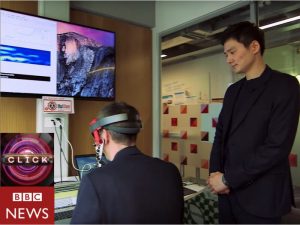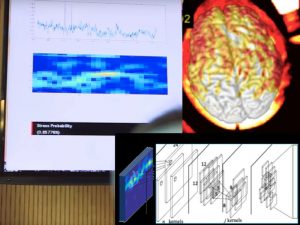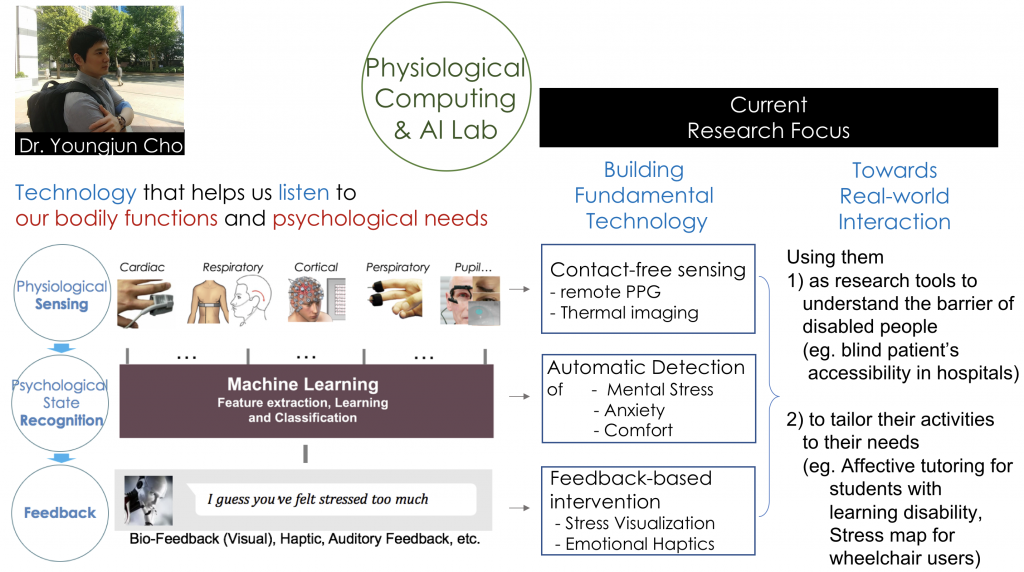Research Supervision
We are now hiring PhD students !

Non-contact Physiological Measurement
As humans are homeothermic, our internal temperature is closely linked with numerous physiological and psychological mechanisms. Given this, human thermal patterns have been explored to improve the understandings of our body for a couple of centuries (Cho, 2019). Researchers have shown that physiological signatures can be captured via non-contact thermal imaging (e.g. respiration monitoring in Cho et al. 2017). Whilst other contactless sensing methods, such as, RGB camera-based photo-plethysmography suffer from illumination and privacy issues, thermography is much less affected by those constraints (Lloyd, 2013). In addition, studies have shown that different types of physiological activities can be read through the use of a thermal imaging channel (Garbey et al., 2007, Pavlidis et al., 2012, Cho et al. 2017-2019), including respiratory, cardiovascular, perspiratory responses.
In our lab, we have been mainly investigating how to improve reliability, accuracy in physiological measurements through thermal imaging (to support real-world situations). At the same time, we have been building remote PPG (photo-plethysmography) algorithms using normal RGB cameras.
References
1. Cho, Y., Julier, S. J. & Bianchi-Berthouze, N. Instant Stress: Detection of Perceived Mental Stress Through Smartphone Photoplethysmography and Thermal Imaging. JMIR Mental Health 6, e10140 (2019).
2. Cho, Y., Julier, S. J., Marquardt, N. & Bianchi-Berthouze, N. Robust tracking of respiratory rate in high-dynamic range scenes using mobile thermal imaging. Biomed. Opt. Express, BOE 8, 4480–4503 (2017).
3. Cho, Y. Automated Mental Stress Recognition through Mobile Thermal Imaging. in the 7th International Conference on Affective Computing and Intelligent Interaction, ACII 2017 596–600 (2017).
4. Garbey, M., Sun, N., Merla, A. & Pavlidis, I. Contact-Free Measurement of Cardiac Pulse Based on the Analysis of Thermal Imagery. IEEE Transactions on Biomedical Engineering 54, 1418–1426 (2007).
5. Pavlidis, I. et al. Fast by Nature – How Stress Patterns Define Human Experience and Performance in Dexterous Tasks. Sci Rep 2, (2012).
6. Lloyd, J. M. Thermal Imaging Systems. (Springer Science & Business Media, 2013).

Automatic Recognition of Psychological States (eg. Mental Stress)
With sensing technology becoming pervasive in our everyday life, the ability to monitor human psychological states has become important in human computer interaction. Amongst such states, high level mental stress or mental workload is a common problem affecting mental, physical health and life in our modern society (Nash & Thebarge, 2006; McEwen, 2007; Arnsten, 2009). Studies show that mental stress could be automatically assessed through the use of these physiological sensing technologies, in turn opening new potential ways for stress management support strategies (Healey & Picard, 2005; Hosseini & Khalilzadeh, 2010; Hernandez et al., 2011; Hong et al., 2012; Sano & Picard, 2013; Al-Shargie et al., 2016; Yu et al., 2018; Cho et al., 2017,2018,2019). However, to date, such available technologies are still relatively fragile, or restrict mobility, movement and measurement environments, limiting their use. Given this we have been focusing on building new approaches to more reliable automatic recognition of psychological states, especially, mental stress, using low-cost and mobile sensing technology, supporting unconstrained and potentially a variety of everyday situations.
References
1. Nash, J. M. & Thebarge, R. W. Understanding Psychological Stress, Its Biological Processes, and Impact on Primary Headache. Headache: The Journal of Head and Face Pain 46, 1377–1386 (2006).
2. McEwen, B. S. Physiology and Neurobiology of Stress and Adaptation: Central Role of the Brain. Physiological Reviews 87, 873–904 (2007).
3. Arnsten, A. F. T. Stress signalling pathways that impair prefrontal cortex structure and function. Nat Rev Neurosci 10, 410–422 (2009).
4. Healey, J. A. & Picard, R. W. Detecting stress during real-world driving tasks using physiological sensors. IEEE Transactions on Intelligent Transportation Systems 6, 156–166 (2005).
5. Hosseini, S. A. & Khalilzadeh, M. A. Emotional Stress Recognition System Using EEG and Psychophysiological Signals: Using New Labelling Process of EEG Signals in Emotional Stress State. in 2010 International Conference on Biomedical Engineering and Computer Science 1–6 (2010). doi:10.1109/ICBECS.2010.5462520
6. Hernandez, J., Morris, R. R. & Picard, R. W. Call Center Stress Recognition with Person-Specific Models. in Affective Computing and Intelligent Interaction 125–134 (Springer, Berlin, Heidelberg, 2011). doi:10.1007/978-3-642-24600-5_16
7. Hong, J.-H., Ramos, J. & Dey, A. K. Understanding Physiological Responses to Stressors During Physical Activity. in Proceedings of the 2012 ACM Conference on Ubiquitous Computing 270–279 (ACM, 2012). doi:10.1145/2370216.2370260
8. Sano, A. & Picard, R. W. Stress Recognition Using Wearable Sensors and Mobile Phones. in 2013 Humaine Association Conference on Affective Computing and Intelligent Interaction 671–676 (2013). doi:10.1109/ACII.2013.117
9. Al-Shargie, F. et al. Mental stress assessment using simultaneous measurement of EEG and fNIRS. Biomedical optics express 7, 3882–3898 (2016).
10. Yu, B., Funk, M., Hu, J., Wang, Q. & Feijs, L. Biofeedback for Everyday Stress Management: A Systematic Review. Front. ICT 5, (2018).
11. Cho, Y. Automated Mental Stress Recognition through Mobile Thermal Imaging. in the 7th International Conference on Affective Computing and Intelligent Interaction, ACII 2017 596–600 (2017).
12. Cho, Y., Bianchi-Berthouze, N. & Julier, S. J. DeepBreath: Deep Learning of Breathing Patterns for Automatic Stress Recognition using Low-Cost Thermal Imaging in Unconstrained Settings. in the 7th International Conference on Affective Computing and Intelligent Interaction, ACII 2017 456–463 (2017).
13. Cho, Y., Julier, S. J. & Bianchi-Berthouze, N. Instant Stress: Detection of Perceived Mental Stress Through Smartphone Photoplethysmography and Thermal Imaging. JMIR Mental Health 6, e10140 (2019).
